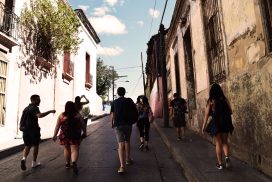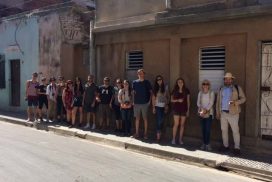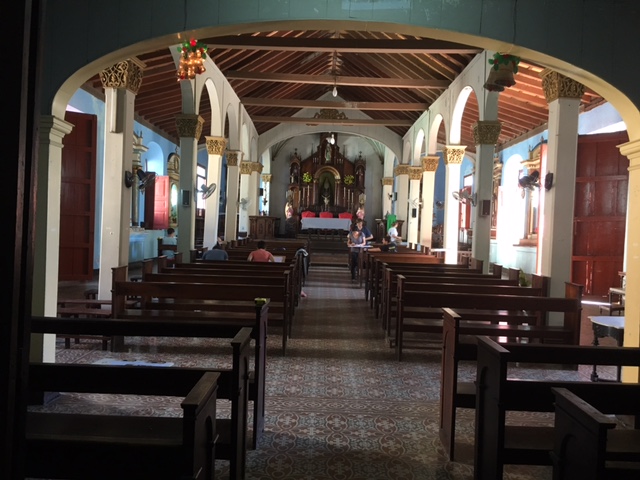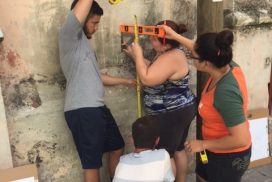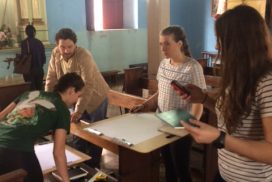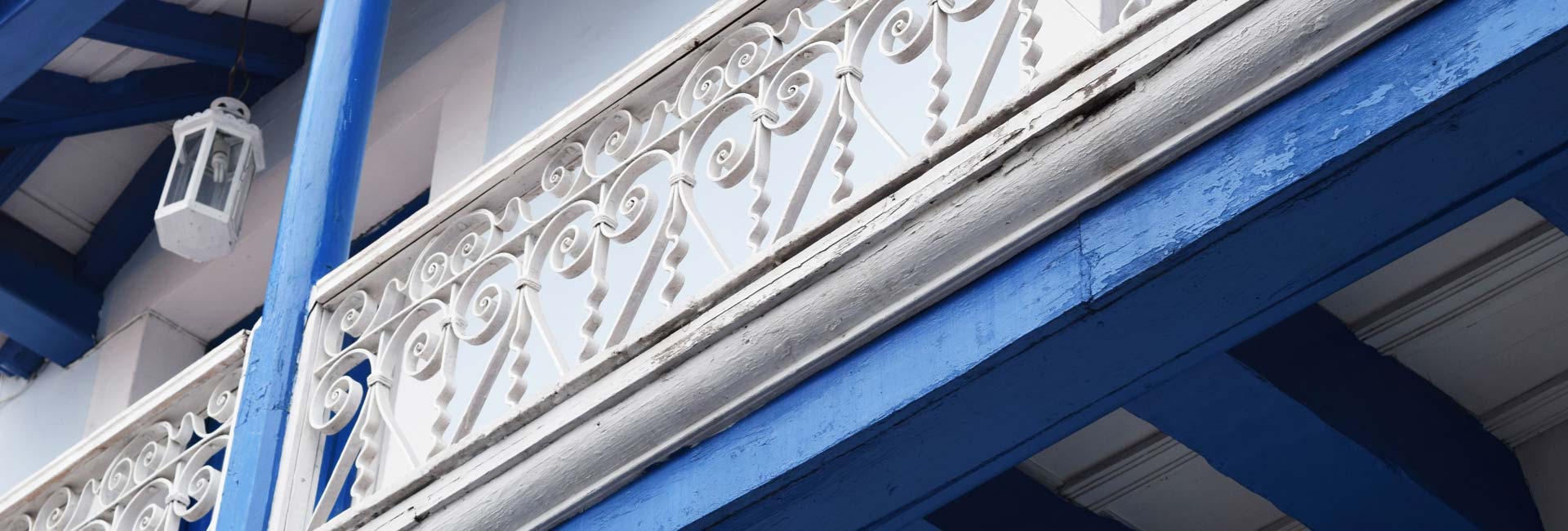

UM Architecture professors and students have a long and varied connection to Cuba and its unique architectural past.
On a sunny January day in Santiago de Cuba, Oriente, 13 students at the University of Miami’s School of Architecture scurried through the halls of the Church of Santa Lucia looking for the iconic eyes among the wooden crosses and stone masonry of the Colonial-style sanctuary.
“Karen Mathews, an art historian who went with us to Cuba, told us that since Santa Lucia gouged her eyes out in her devotion to the Lord, there were figures of eyes hidden somewhere on the church,” says Jorge Hernandez, professor in the School of Architecture.
The unusual scavenger hunt was one of the many highlights of a recent 11-day trip to the island by architecture students who traveled with Hernandez and fellow faculty members: lecturer Ricardo Lopez and Carie Penabad, associate professor and director of undergraduate studies. Matthews, assistant professor in the Department of Art and Art History at the College of Arts and Sciences, also worked on the project.
Their mission, as part of the Historic Preservation and Documentation of Historic Buildings studio class, was to begin the refurbishing process for the Church of Santa Lucia, built in 1701 and one of 12 churches that were designated to the World Monuments Watch by the World Monuments Fund. They are considered cultural heritage sites that face imminent challenges.
“I think the trip helped to demystify the place for many of the students,” says Cuban-born Hernandez, who was crucial in helping the Cuban Catholic Church get the World Monuments Fund designation. “They were able to confirm for themselves the state of the island, the quality of the people and the architecture.”
The students spent eight-hour days measuring the inside of the church, sketching its architectural features and drawing blueprints, as well as interacting with other visiting architects and students from Europe who were studying the places of worship in Oriente, Cuba’s easternmost province.
“I never knew what Cuba looked like and when I got there and saw the deterioration, it blew me away,” says Camille Cortes, a 21-year-old architecture student on her first trip to the island. “It was a very special trip.”
The students were lodged at the Church’s retreat house and spent time getting to know the locals, as well as the needs of Santa Lucia’s parishioners. In April, as part of their class, they are presenting their building proposals for the Church, which will include ancillary buildings for the parishioners, says Hernandez.
Exploring Cuba’s architecture has been the clarion call for thousands of artists, painters, tourists, academics and, of course, architects throughout the years. As the largest island in the Caribbean, Cuba enjoyed a privileged position for the Spanish conquistadores because of its geographic location. Havana became a prosperous port of entry to the New World and the Spanish spent great wealth in building fortresses to protect the country’s capital, which is unlike any other in the hemisphere.
“What is extraordinary about Havana is that for more than four centuries the city has benefitted from a confluence of European, African and American influences,” says Penabad, whose parents are from Cuba.
About the Photo
Architectural details in Santiago de Cuba. Photo credit: Lok Chan
Join the Conversation:
Follow on
Twitter:
UM School of Architecture, @UM_SoA
UM College of Arts
and Sciences, @UMCAS
University of
Miami, @univmiami
UM News, @univmiaminews
Inside
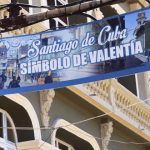
Connections to the Past
A University of Miami architecture student discovered her mother’s childhood home and … More
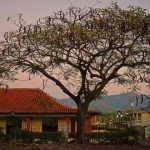
Unexpected Reception
UM School of Architecture student Lok Chan found that her Chinese ancestry was of great … More
“The monumental scale of the city is extraordinary. When walking from the city center towards the west, every period is represented in architectural history and every period is substantial: the colonial era, the republican era, the art deco buildings, the garden city,” Penabad adds. “What is also extraordinary is the coexistence of exceptional architecture and urbanism.”
While many American cities were “dismembered” to accommodate automobiles in the ‘60s and ‘70s, that fate did not fall upon Havana. The advent of the Cuban revolution in 1959 froze all work in the capital as resources were sent to the provinces.
In this time-lapse video produced by Amin Sarafraz of UM’s Center for Computational Science, students spend time exploring the Church of Santa Lucia in Santiago de Cuba.
“The city, although deteriorated, remains pretty much frozen in time,” says Sonia Chao, a research associate professor at the School of Architecture and daughter of Cuban emigrants. “Each layer of Havana’s 500-year architectural and urban legacy, and their respective inherent lessons, remains clear.”
“That’s invaluable and it makes Havana a really unique place for our students to learn about urbanism and architecture,” adds Chao, director of the Center for Urban and Community Design.
Her involvement in Cuba goes back to 2002. Under the tutelage of a U.S. foundation, she has visited the island on numerous occasions, re-opening the door to academic dialogues and collaborating on historic preservation, sustainability, urban design and building codes, with faculty and students from UM and the University of Havana’s CUJAE-Instituto Superior Politecnico José Antonio Echevarría, and the Offices of the Historian in the cities of Havana, Cienfuegos and Santiago.
Her scholarly activities on Cuban architecture include design workshops, lectures, exhibitions, including one at the second Architecture Biennial in Havana, and multiple publications, including a book due out later this year. Chao’s extensive academic work fostered the form-based preservation minded design and building codes that eventually emerged for three historic neighborhoods in Havana.
With foundation support, hundreds of books in Spanish were donated to the CUJAE. Others were edited and produced in collaboration with local academics on urbanism and coding trends that would prove seminal for Cuban architects and students.
“The local academics are the curators of that great (Cuban) urbanism and architecture,” says Chao, who, since 2004 has been teaching a popular class at UM called Havana: The Challenges and Opportunities of Preserving the Past. “To think that they wouldn’t have the most recent kind of information at their disposal seemed to put them at a handicap.”
(Story continues after photo gallery)
Other faculty has been instrumental in establishing academic relationships with Cuban scholars, such as Rafael Fornes, lecturer at the School of Architecture.
“Ever since its founding, the University of Miami School of Architecture has had huge interest with Cuba,” says Fornes. “There have been great exchanges between professors.”
Since 1996, Fornes has taught a class called Studies of La Habana at UM which explores not only the architecture, but the culture of the city as well. Using his many contacts on the island, he led student trips to Cuba as a visiting professor for Notre Dame and Yale Universities. After 1996, when it became near impossible to travel to Cuba, Fornes organized trips to such places as New Orleans, Key West and Saint Augustine, cities that have “a great Cuban influence.”
Born and raised in Havana, Fornes graduated from the CUJAE in 1981 and worked on several projects in his native Cuba. After immigrating to Hungary, Fornes moved to Miami in 1992 and came to know several prominent Cuban-American architects, including Andres Duany, lecturer at the School of Architecture. Duany and former Dean of the UM School of Architecture Elizabeth Plater-Zyberk, both highly influential architects, are credited with launching the New Urbanism movement.
In 1998, Fornes returned to Cuba to teach a series of seminars at the CUJAE on Miami’s Architecture and Urbanism. The seminars were very well received and gradually opened the way for other UM professors to visit the island.
In the early 2000’s, Duany began a series of lectures to University of Havana architecture students on New Urbanism. His lectures were captured in a book titled Charlas en el Capitolio de La Habana Sobre el Nuevo Urbanismo (Talks at the Havana Capitol Building on New Urbanism).
The work of School of Architecture faculty in the island continues. In November 2016, Fornes and lecturers Jorge Trelles and Ricardo Lopez participated in the Convenciόn Científica de Ingenieria y Arquitectura (The Scientific Convention of Engineering and Architecture) at the Convention Center in Havana.
Recently, UM Professor Victor Deupi, the son of Cuban-born architects, and his colleague, Professor Jean-Francois Lejeune curated an exhibit, “Cuban Architects at Home and in Exile: The Modernist Generation,” at the Coral Gables Museum. The display covered the work of prominent Cuban architects inside and outside the island demonstrating the breadth and diversity of Cuban architecture. Dozens of pictures, drawings, documents and letters were on display along with photos of buildings from the Tropicana Night Club to the National Bank in Havana.
For Deupi, getting to know many of the architects in the exhibit had a special meaning.
“This was my father’s generation,” says Deupi. “They were his teachers, his colleagues, mentors and his employers,” he says.
Deupi says much of the archival items came from boxes that had been long forgotten and stored away in closets by the relatives of the architects or the architects themselves. Thanks to the success of the exhibit, most of the documents, photos, maps and other architectural objects will be donated to the UM Libraries Cuban Heritage Collection (CHC) so that the legacy of these Cuban architects will be preserved and available for posterity.
“We are building the archive of Cuban architecture,” Deupi says.
- BARBARA GUTIERREZ / UM News
